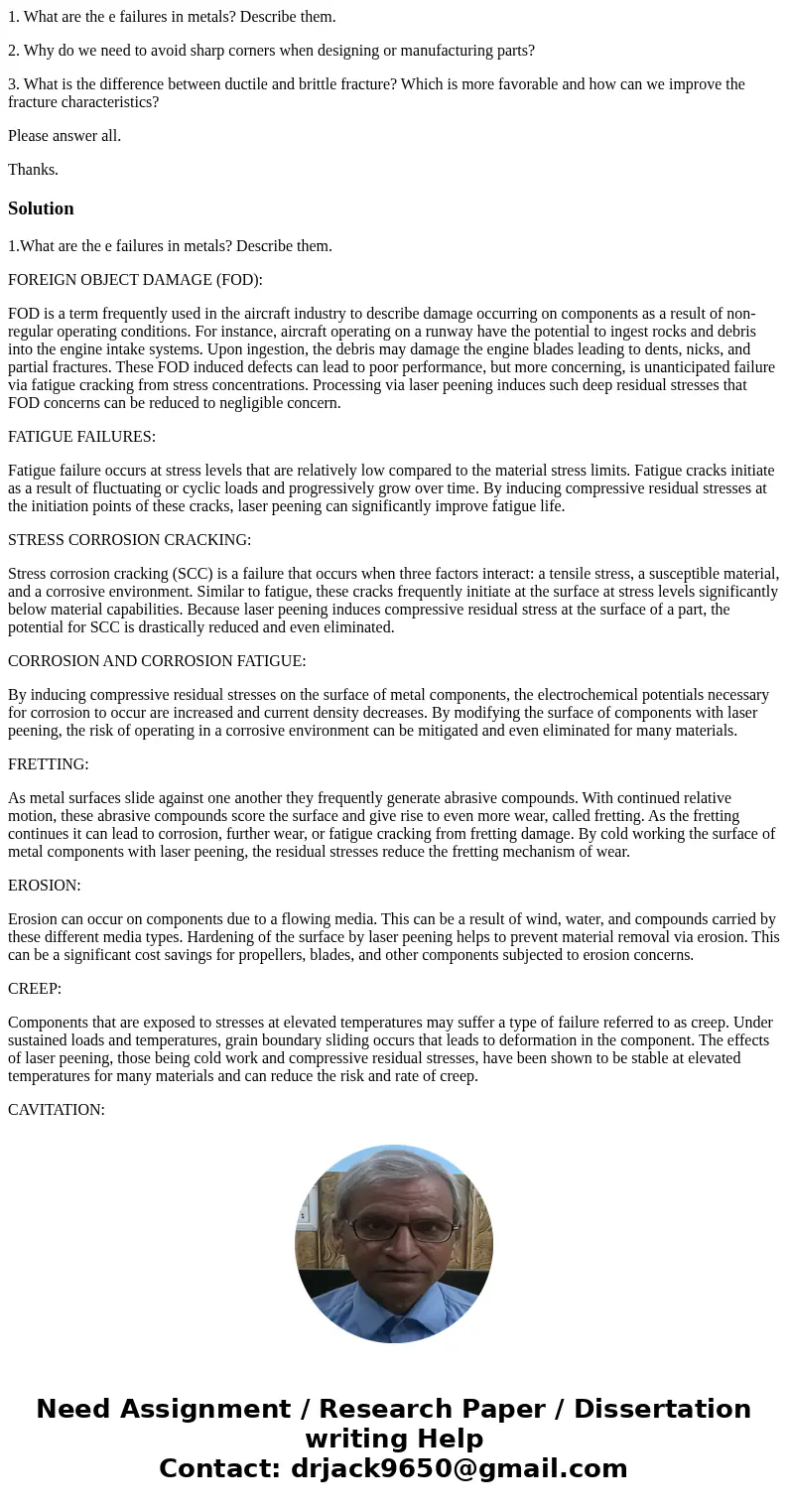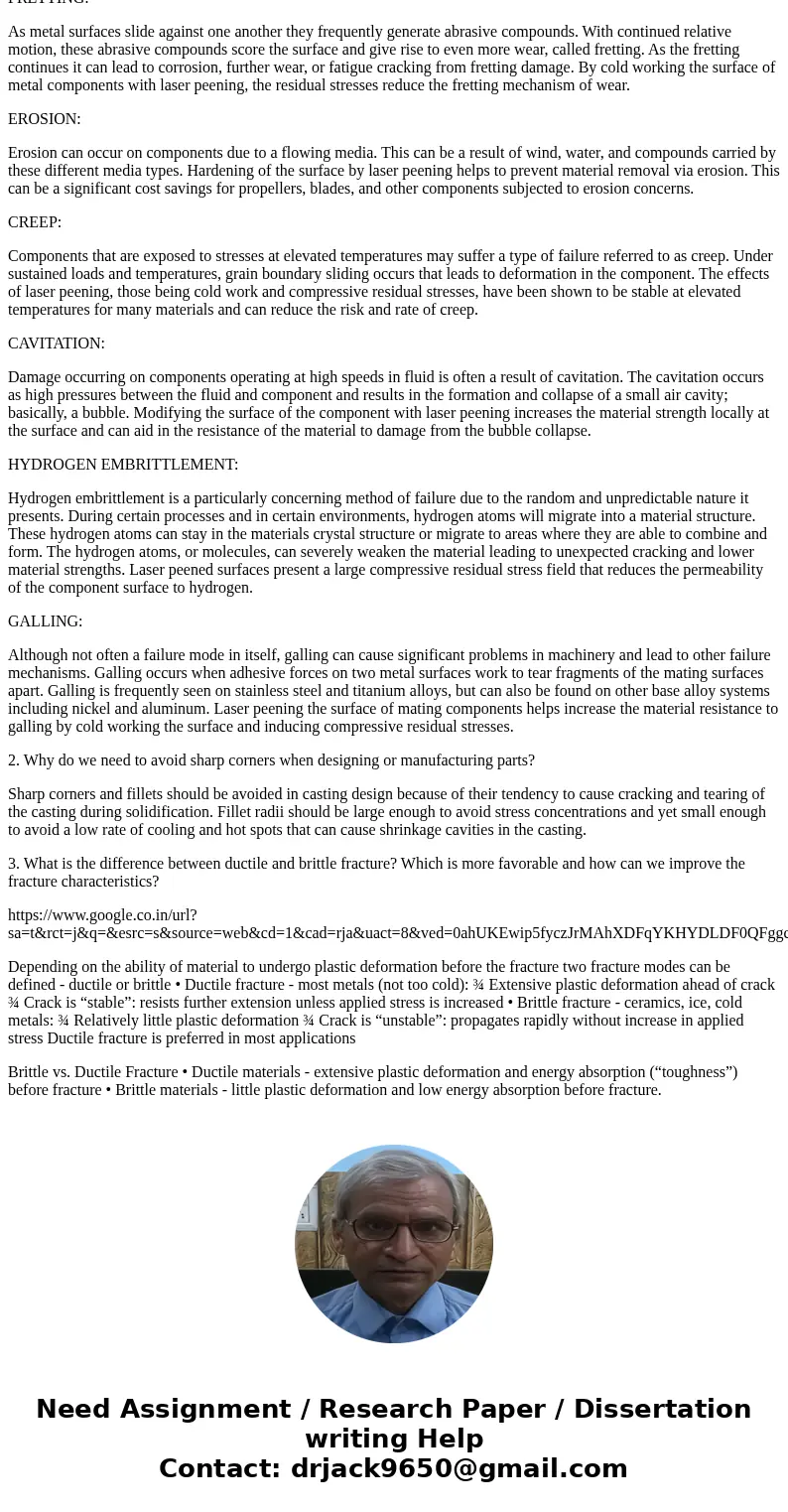1 What are the e failures in metals Describe them 2 Why do w
1. What are the e failures in metals? Describe them.
2. Why do we need to avoid sharp corners when designing or manufacturing parts?
3. What is the difference between ductile and brittle fracture? Which is more favorable and how can we improve the fracture characteristics?
Please answer all.
Thanks.
Solution
1.What are the e failures in metals? Describe them.
FOREIGN OBJECT DAMAGE (FOD):
FOD is a term frequently used in the aircraft industry to describe damage occurring on components as a result of non-regular operating conditions. For instance, aircraft operating on a runway have the potential to ingest rocks and debris into the engine intake systems. Upon ingestion, the debris may damage the engine blades leading to dents, nicks, and partial fractures. These FOD induced defects can lead to poor performance, but more concerning, is unanticipated failure via fatigue cracking from stress concentrations. Processing via laser peening induces such deep residual stresses that FOD concerns can be reduced to negligible concern.
FATIGUE FAILURES:
Fatigue failure occurs at stress levels that are relatively low compared to the material stress limits. Fatigue cracks initiate as a result of fluctuating or cyclic loads and progressively grow over time. By inducing compressive residual stresses at the initiation points of these cracks, laser peening can significantly improve fatigue life.
STRESS CORROSION CRACKING:
Stress corrosion cracking (SCC) is a failure that occurs when three factors interact: a tensile stress, a susceptible material, and a corrosive environment. Similar to fatigue, these cracks frequently initiate at the surface at stress levels significantly below material capabilities. Because laser peening induces compressive residual stress at the surface of a part, the potential for SCC is drastically reduced and even eliminated.
CORROSION AND CORROSION FATIGUE:
By inducing compressive residual stresses on the surface of metal components, the electrochemical potentials necessary for corrosion to occur are increased and current density decreases. By modifying the surface of components with laser peening, the risk of operating in a corrosive environment can be mitigated and even eliminated for many materials.
FRETTING:
As metal surfaces slide against one another they frequently generate abrasive compounds. With continued relative motion, these abrasive compounds score the surface and give rise to even more wear, called fretting. As the fretting continues it can lead to corrosion, further wear, or fatigue cracking from fretting damage. By cold working the surface of metal components with laser peening, the residual stresses reduce the fretting mechanism of wear.
EROSION:
Erosion can occur on components due to a flowing media. This can be a result of wind, water, and compounds carried by these different media types. Hardening of the surface by laser peening helps to prevent material removal via erosion. This can be a significant cost savings for propellers, blades, and other components subjected to erosion concerns.
CREEP:
Components that are exposed to stresses at elevated temperatures may suffer a type of failure referred to as creep. Under sustained loads and temperatures, grain boundary sliding occurs that leads to deformation in the component. The effects of laser peening, those being cold work and compressive residual stresses, have been shown to be stable at elevated temperatures for many materials and can reduce the risk and rate of creep.
CAVITATION:
Damage occurring on components operating at high speeds in fluid is often a result of cavitation. The cavitation occurs as high pressures between the fluid and component and results in the formation and collapse of a small air cavity; basically, a bubble. Modifying the surface of the component with laser peening increases the material strength locally at the surface and can aid in the resistance of the material to damage from the bubble collapse.
HYDROGEN EMBRITTLEMENT:
Hydrogen embrittlement is a particularly concerning method of failure due to the random and unpredictable nature it presents. During certain processes and in certain environments, hydrogen atoms will migrate into a material structure. These hydrogen atoms can stay in the materials crystal structure or migrate to areas where they are able to combine and form. The hydrogen atoms, or molecules, can severely weaken the material leading to unexpected cracking and lower material strengths. Laser peened surfaces present a large compressive residual stress field that reduces the permeability of the component surface to hydrogen.
GALLING:
Although not often a failure mode in itself, galling can cause significant problems in machinery and lead to other failure mechanisms. Galling occurs when adhesive forces on two metal surfaces work to tear fragments of the mating surfaces apart. Galling is frequently seen on stainless steel and titanium alloys, but can also be found on other base alloy systems including nickel and aluminum. Laser peening the surface of mating components helps increase the material resistance to galling by cold working the surface and inducing compressive residual stresses.
2. Why do we need to avoid sharp corners when designing or manufacturing parts?
Sharp corners and fillets should be avoided in casting design because of their tendency to cause cracking and tearing of the casting during solidification. Fillet radii should be large enough to avoid stress concentrations and yet small enough to avoid a low rate of cooling and hot spots that can cause shrinkage cavities in the casting.
3. What is the difference between ductile and brittle fracture? Which is more favorable and how can we improve the fracture characteristics?
https://www.google.co.in/url?sa=t&rct=j&q=&esrc=s&source=web&cd=1&cad=rja&uact=8&ved=0ahUKEwip5fyczJrMAhXDFqYKHYDLDF0QFggcMAA&url=http%3A%2F%2Fpeople.virginia.edu%2F~lz2n%2Fmse209%2FChapter8.pdf&usg=AFQjCNG1S9CtzWw8G7zcGE_Fzw1ZJ_WSSA
Depending on the ability of material to undergo plastic deformation before the fracture two fracture modes can be defined - ductile or brittle • Ductile fracture - most metals (not too cold): ¾ Extensive plastic deformation ahead of crack ¾ Crack is “stable”: resists further extension unless applied stress is increased • Brittle fracture - ceramics, ice, cold metals: ¾ Relatively little plastic deformation ¾ Crack is “unstable”: propagates rapidly without increase in applied stress Ductile fracture is preferred in most applications
Brittle vs. Ductile Fracture • Ductile materials - extensive plastic deformation and energy absorption (“toughness”) before fracture • Brittle materials - little plastic deformation and low energy absorption before fracture.


 Homework Sourse
Homework Sourse